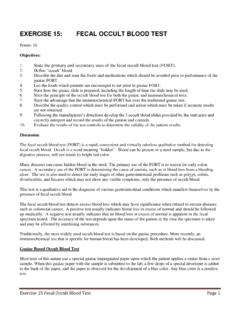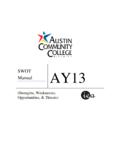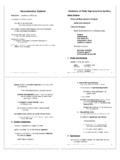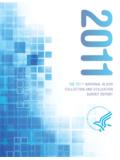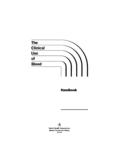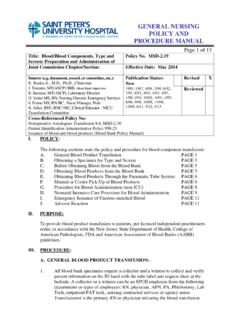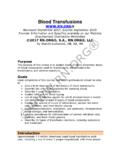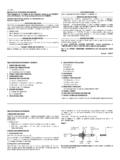Transcription of 2. Blood and Components - Austin Community …
1 1 MLAB 2431 Unit 2 Blood and Blood ComponentsUnit 2 Blood and Blood of Blood collection , preparation and viability and physical bacterial Preservative prevents clotting and preservatives provide proper nutrients for continued metabolismof cells during as an anticoagulant be transfused within 48 hours preferably within 8 approved for whole Blood storage are:Citrate Phosphate Dextrose (CPD)Citrate Phosphate 2 Dextrose (CP2-D)Citrate Phosphate Dextrose Adenine (CPD-A1)Storage Time21 days35 daysTemperature1-6 C1-6 CSlows glycolytic activity so dextrose is not rapidly consumedAdenineNoneAdded adenine provides substrate from which RBCscan synthesize ATP during storage, improvesviabilityVolume450 mLs or 500 mLs + 10%450 mLs or 500 mLs + 10%Dextrose - supports continuing ATP generation by glycolytic pathwayCitrate - prevents coagulation by binding ionized calcium which is required for coagulation cascade3.
2 Additive solutions consists of primary bag with satellite bags attached, one of which contains the additivesolution, 3 formulations AS-1, AS-3, and drawn into the primary bag containing CPD rich plasma is removed and a second preservative solution which consists of saline,adenine, glucose and mannitol (SAGMAN) is added to the RBCs to extend red cell storage to42 days and has a final hematocrit of 66%. must be removed and AS added within 72 hours of 2431 Unit 2 Blood and Blood Which Occur During Blood life or expiration allowable storage time results in 75% recovery means that at least 75% of the transfused cells remain in the recipient'scirculation 24 hours after to the measurable biochemical changes which occur when Blood is stored at 1-6 dissociation curve is affected by biochemical changes and may cause increased affinityof hemoglobin for )Low 2,3-DPG levels cause greater affinity for oxygen resulting in less O2 to )pH drops due to cellular metabolism, causes 2,3-DPG levels to )
3 Following transfusion stored donor rbcs regenerate ATP and 2,3-DPG functional platelets left and number of viable red cells lesion clinically significant for infants and patients needing massive of biochemical changes which occur ,3 DPG increases in decreases in hemoglobin increases in Preparation of prevent partial activation of coagulation system unit should be collected within 15 minutes withminimal trauma to the for Components drawn into primary bag with attached satellite bags to avoid breaking thehermetic seal when removing Components (closed system). hermetic seal is broken component must be transfused within 24 hours if stored at 1-6 C or within4 hours if stored at 20-24 prepare Components , Blood must not be chilled and platelets must be removed within 8 hours Blood using a "light" spin (2000xg, 3").
4 Integral seal, express platelet rich plasma (top layer) into satellite bag then seal tubingbetween primary and satellite bag, place primary bag with RBCs at 1-6 . platelet rich plasma using a "heavy" spin (5000 x g, 5 minutes). the supernatant platelet-poor plasma into the second transfer bag and seal the plasma at -18 C or lower (FDA requires it to be frozen solid within 8 hours ofcollection), platelets are stored at 20-24 C with constant make cryoprecipitate thaw frozen plasma at 1-6 C. When plasma has a slushy consistencyremove the plasma to satellite bag, leaving behind the precipitated CRYO. CRYO at -18 C or lower. Can refreeze plasma to be used as single donor red Blood cells which have been left in the primary bag may be handled in 2 )If collected in CPD will have a 21 day )Add an additive solution to the RBCs, unit will have 42 day )All liquid RBCs are stored at 1-6 2431 Unit 2 Blood and Blood summary the following Components are routinely prepared from a unit of whole Blood .
5 1)Packed Red Blood Cells (RBC)2)Fresh Frozen Plasma (FFP)3)Cryoprecipitate (CRYO)4)Single donor plasma (SDP)5)Platelets (PC or RD PC) - NOTE- nationally going to pheresis docking device allows tubing to be separated and joined with other tubing without exposure tobacterial primarily to add additional satellite bags to donor units which allows aliquoting of theunit, each aliquot retains the original expiration also be used to "pool" units of platelets and control requires certain number of units, usually 4 per month, to be tested to ensure thecomponent contains the required number or amount of Information About Blood is separated into Components to allow treatment of patients with specific Blood products for of separation of Whole Blood into optimum survival for each of only that component of Blood the patient of Blood or Blood Components requires a doctors Blood and Components must be administered through a as quickly as the patient can tolerate it, preferably within 4 D negative recipients should be transfused with D negative cellular possible Components should be ABO identical and must be ABO "Universal Donor" for cellular products is group O.
6 For plasma products it is group Whole Blood is not usually available until 12-24 hours after for fresh whole Blood (<7-10 days old) are:1)Newborns needing exchange transfusion so full levels of 2,3-DPG are )Patient requiring leukoreduced Blood products, in US products leukoreduced of component storage RBCs 1-6 , thawed CRYO and Granulocytes 20-24 C (RT). frozen plasma component < -18 liquid plasma component 1-6 C EXCEPT thawed will focus on the most commonly used Components keeping in mind that additional processingcan be performed to make additional types of break the discussion down into cellular Components and plasma 2431 Unit 2 Blood and Blood Blood Blood (WB) indications for use of WB are extremely for massive transfusion to correct acute hypovolemia such as in trauma and used today, platelets non-functional, labile coagulation factors be ABO identical due to ABO antibodies present in Blood Cells (RBCs) to treat symptomatic anemia and routine Blood loss during is approximately 80% for non-additive (CPD), 60% for additive (ADSOL).
7 WB to sediment or centrifuge WB, remove supernatant Blood Cells Leukocyte in Blood products can induce adverse affects during transfusion, primarily febrile,non-hemolytic thinking attributes reactions to cytokines produced by leukocytes in transfused explanations to reactions include: immunization of recipient to transfused HLA orgranulocyte antigens, micro aggregates and fragmentation of , indicated only for patients who had 2 or more febrile transfusion reactions, nowa commonly ordered, popular CMV safe Blood , since CMV lives in Blood centers in the now leukoreduce Blood immediately after side filters are available to leukoreduce products during Red Blood Cells (W-RBCs) the unit removes plasma proteins, platelets, WBCs and micro aggregates which maycause febrile or urticarial requiring this product is the IgA deficient patient with anti-IgA by using a machine which washes the cells 3 times with saline to remove and types of labels.
8 1)Washed RBCs - do not need to QC for )Leukocyte Poor WRBCs, QC must be done to guarantee removal of 85% of longer considered effective method for leukoreduction. 24 hours after unit is Red Blood Cells; Deglycerolized Red Blood Cells (D-RBC) is frozen to preserve: rare types, for autologous transfusion, stock piling Blood formilitary mobilization and/or civilian natural is drawn into an anticoagulant )Plasma is removed and glycerol is )After equilibration unit is centrifuged to remove excess glycerol and Expiration1)If frozen, 10 )After deglycerolization, 24 temperature1)high glycerol -65 )low glycerol -120 C, liquid 2431 Unit 2 Blood and Blood of donor unit, removal of )Thaw unit at 37C, thawed RBCs will have high concentration of )A solution of glycerol of lesser concentration of the original glycerol is )This causes glycerol to come out of the red Blood cells slowly to prevent hemolysis ofthe )
9 After a period of equilibration the unit is spun, the solution is removed and a solutionwith a lower glycerol concentration is )This procedure is repeated until all glycerol is removed, more steps are required for thehigh glycerol stored )The unit is then Red Blood special solution is added to expired RBCs up to 3 days after expiration to restore 2,3-DPGand ATP levels to prestorage RBCs regain normal characteristics of oxygen transport and delivery andimproved post transfusion is 24 hours or, if frozen, 10 (PLTS) to prevent spontaneous bleeding or stop established bleeding in from a single unit of whole to storage at RT it is the most likely component to be contaminated with dose for adults is 6 to 10 patients become "refractory" to platelet is 5 days as a single unit, 4 hours if at 20-24 C (RT) with constant negative patients should be transfused with D negative platelets due to the presence of asmall number of Platelet to decrease donor exposure, to obtain HLA matched platelets for patients who arerefractory to RD-PC or prevent platelet refractoriness from by pheresed unit is equivalent to 5-6 at 20-24 C (RT) with agitation for 5 days.
10 NOTE: FDA considering extension to 7 daysif bacterial contamination identification is negative patients should be transfused with D negative platelets due to the presence of asmall number of use is for patients with neutropenia who have gram negative infections documentedby culture, but are unresponsive to efficacy and indications for granulocyte transfusions are not well antimicrobial agents and use of granulocyte and macrophage colony stimulating factorsbest for adults, best success with this component has been with transfusions are by time is 24 hours but best to infuse at 20-24 2431 Unit 2 Blood and Blood Frozen Plasma (FFP) to replace labile and non-labile coagulation factors in massively bleeding patients ORtreat bleeding associated with clotting factor deficiencies when factor concentrate is be frozen within 8 hours of )frozen - 1 year stored at <-18 - 7 years stored at <-65 )thawed - 24 temperature1)frozen -18 C, preferably -30 C or lower2)thawed - 1-6 in 30-37C water bath or FDA approved have mechanism to detect units which have thawed and refrozen due to improper be ABO Plasma/Solvent Detergent Treated (SD Plasma)

